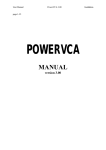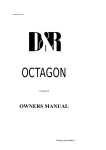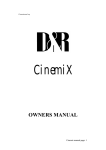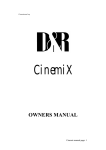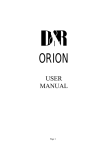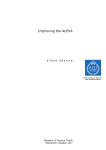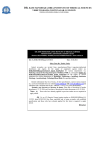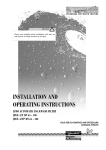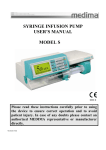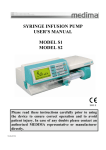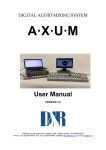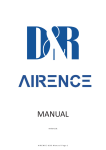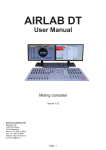Download OWNERS MANUAL - D&R Broadcast Mixing Consoles
Transcript
Octagonman.lwp OCTAGON (version1.2) OWNERS MANUAL Octagon page number 1 Octagon Manual version: 1.1 Introduction and Product Overview 1.0 The Chassis system - description 1.1 Octagon chassis 2.0 Master section - description 2.1 Oscillator / Talk back section 2.2 Talk back section 2.3 Listen section 2.4 Studio 1 - 2 sections 2.5 2-Tracks 2.6 Solo section 2.7 Control Room Monitor section 2.8 Near fields 2.9 Dim 2.10 CRM switches 2.11 CRM mutes 2.12 CRM preset 2.13 CRM Dim / mutes 2.14 Main fader 2.15 Main LCD screen 2.16 Dynamics section 2.17 Console Recall / Reset 2.18 Joysticks 2.19 Communications 2.20 Control Monitor Matrix 2.21 Track ball 2.22 AUX.. Master section 2.23 Metering 2.24 Master Inputs / Outputs 3.0 "Dual-Path" mono module 3.1 Upper section 3.2 Equalizer section Upper path 3.3 Aux. 1-16 section 3.4 Pan pot 3.5 Insert 3.6 Dynamics 3.7 PHASE 3.8 AUTO 3.9 PFL 3.10 PEAK 3.11 Solo System 3.12 Fader Calibration 3.13 Group Control Display Octagon page number 2 3.14 3.15 3.16 3.17 3.18 3.19 3.20 3.21 3.22 3.23 3.24 3.25 3.26 3.27 3.28 3.29 3.30 3.31 3.32 3.33 3.34 3.35 3.36 3.37 3.38 4.0 Select Mute Fader Meter Read Upper Routing Status section Lower path AUX. sends Lower path Equalizer section Lower path High Low pass Filter LCRS Pan pot Insert Lower path Dynamics Lower path PHASE Reverse Lower path AUTO Lower path PFL Lower path PEAK Lower path Safe indicator Lower path SOLO System Lower path Group control display Lower path Ready switch Select Lower path MUTE Lower path Fader Upper & Lower path Inputs / Outputs In / Output Module summary The Dual Stereo return module 4.1 Input section 4.2 Equalizer section 4.3 AUX. send section 4.4 Stereo A/B Status Section - Using the Control Module 4.5 Equalizer section 4.6 Balance control 4.7 Stereo B Status Section - Using the Control Module 4.8 Auto 4.9 PFL 4.10 Solo 4.11 SEL 4.12 Mute 4.13 Fader 4.14 Upper Routing Status Section 4.15 Meter read 4.16 Lower path 4.17 LCR control 4.18 Remote 4.19 Stereo A/B status section - using the Control Module. Octagon page number 3 5.0 Octagon’s Control Module 5.1 Group Busses 5.2 Input Selection 5.3 AUX. section 5.4 Pan pot assignment 5.5 Fader Calibration Upper path 5.6 SAFE (SIP) (Upper / Lower path) 5.7 Group Setup (Upper and Lower section) 5.8 LCR Lower path 5.9 ST-SRND ( Stereo-Surround) Lower path 5.10 Meter reads 5.11 Module Select section 5.12 Encoder 5.13 Copy 5.14 Menu 5.15 Show 5.16 Macro 5.17 Escape 5.18 Paste 5.19 All 5.20 Undo 5.21 Clear 5.22 Enter 5.23 Solo 5.24 Mute 5.25 Auto 5.26 Set-Up 5.27 Group Fader 5.28 Macro switches 6.0 MONITOR MATRIX MODULE 6.1 Patch bay description 6.2 Patch bay points 7.0 Instructions for operation 7.1 The Tracking session 7.2 The Playback session 7.3 The Overdub session 7.4 The Remix session 7.5 The MIDI or Virtual session 7.6 Surround mixing 7.7 Six Upper 5.1 DTS (Digital Theater Sound) 7.8 SDDS Film style mixing 8.0 Installation - electrical 8.1 Local Electrical Voltage 8.2 Electrical Wiring Octagon page number 4 9.0 Installation - audio 9.1 Interface with Power Amps 9.2 The Initial Hookup 9.3 Shields & Grounds of Equipment 10.0 Troubleshooting and servicing 10.1 Troubleshooting 10.2 Removing a module 10.3 Patch bay - servicing 11.0 How to use the Octagon 11.1 Control Module 11.2 Setting up the Control Module 11.3 How to use the Control module 11.4 Group output switching 11.5 Input selection 11.6 Aux sourcing and assignment 11.7 Output assignment to master busses 11.8 Fader calibration (FDR CAL) 11.9 Safe 11.10 Lower pan LCR and Stereo surround 11.11 Fader Set 11.12 The Control Module Group master fader section 11.13 CGM solo 11.14 CGM Mute 11.15 CGM Auto 11.16 Meter reads 11.17 Control Module functions 11.18 Machine remote switches 11.20 Master section. 12.0 Connectors 12.1 Master section 12.2 Patch bay connectors 13.0 Specifications 14.0 Signal flow master section 15.0 Signal flow input module 16.0 Digital signal flow 17.0 Level diagram 18.0 Interfacing with DS4E / CP65 19.0 20.0 Interfacing with “Dolby” SEU4 / SDU4 Interfacing with JS 300 Octagon page number 5 21.0 Filmstyle mixing signal flow 22.0 Filmstyle mixing without Matrix 23.0 Filmstyle mixing setup 24.0 Filmstyle mixing with Matrix 25.0 Conformity statement according to ISO/IEC Nr. 22 and EN 45014 26.0 Product safety Octagon page number 6 Dear Octagon owner, The Octagon was created using the latest in computer aided design and assembling technology and incorporates the most advanced circuit components available which results in the Octagon being another D&R product unsurpassed in the electronics industry. In D&R's quest to "raise the standard", Octagon is designed and manufactured to the highest degree. We are confident that the Octagon will play the central roll in producing "state of the art" recordings for many years and wish you much success. We value your suggestions and would appreciate you taking the time to complete and return the questionnaire included at the front of this manual (once you become familiar with your Octagon). We listen and learn from your comments and you can be assured that our research and development department will take your comments very serious. With kind regards, Duco de Rijk President D&R Electronica Weesp b.v. RAISING THE STANDARD Octagon page number 7 Octagon Recording Console The D&R Octagon is a 48 buss, dual path in-line format recording and film style mixing console designed to take the central role in a film sound recording facility. With up to 64 projects storable, the wasted time between sessions is a thing of the past. An essential part of the Octagon is its ability to record and mix down in various output formats ranging from mono up to full SDDS formats. With its digitally controlled software switches you can route any input in the Octagon to a number of places and be able to recall all stored setups by a couple of key strokes. This feature alone saves valuable time between sessions. A first in mixing console technology is Octagon's surround master section with the ability to mix down a 7.1 surround, fully automated. Easy monitoring of all surround outputs is standard and automated Joysticks with Virtual Vision makes 360 degrees panning very easy to lay down in the final mix. Completely modular, Octagon can be configured precisely to suit your particular system requirements. An Octagon standard is the internally wired patch bay that interfaces with all external equipment using 25 pin sub D connectors, and chassis mount XLR connectors. To become completely familiar with your Octagon and gain the maximum benefit from its use, we recommend that you read this manual thoroughly. It will provide important information about all aspects of the Octagon including; installation, operation, and servicing. Head Office / Factory D&R Electronica Weesp B.V. Rijnkade 15B 1382 GS Weesp The Netherlands Tel: (-) 31 294 418 014 Fax: (-) 31 294 416 987 Website: http://www.d-r.nl E-mail: [email protected] Octagon page number 8 Octagon's CHASSIS SYSTEM 1.1 OCTAGON'S CHASSIS The Octagon is available in two frame sizes; 60 and 84. The basic frame has one blank module located on the extreme left of the frame. The two blanks positioned left and right from the master section are part of the master sections electronics and can not be replaced by input modules or other equipment filling these positions. The blank on the far left side of the frame cannot be replaced with an input module as they conceal mechanical constructions and internal wiring. Included with Octagon's frame are; the master section with associated VU or LED peak metering, patch bay, all internal cable harnessing, and rack mount power supplies. Frame 60 The frame 60 will fit 60 dual path mono modules, a maximum of two control modules and a maximum of 8 dual path stereo modules, the master section, and patch bay. Frame 60 standard configuration: From left to right; 16 dual path mono modules, control module, 8 dual path mono modules, master section, 16 dual path mono modules, a control module, 8 dual path mono modules, a blank module and a maximum of 8 dual path stereo return modules (16 stereo returns), and patch bay. Octagon page number 9 Frame 84 The frame 84 will fit 84 dual path mono, a maximum of 4 control modules, 8 dual path stereo modules and a master section and patch bay. Frame 84 standard configuration: From left to right; 24 dual path mono modules, control module, 24 dual path mono input modules, control module, master section, 24 dual path mono modules, control module, 8 dual stereo return modules (16 stereo returns), and patch bay. Note: Octagon's patch bay can be ordered at either end of the frame Delivery contents In this shipment of your Octagon you will find the following parts, please check and contact the factory immediately when something is missing. 1. Your configuration of the Octagon 2. Power supplies (2/3/4x analog, 1/2x motor- and 1/2x Logic power supplies, depending on the size of your console) 3. Manual with software 4. Cables (Serial cable and 4 mains cables) 5. Powerfade software 6. PC display card Octagon page number 10 THE MASTER SECTION 2.0 MASTER SECTION - DESCRIPTION Octagon's master section is equivalent (in width) to 14 input modules. All CRM outputs are located on the rear of the console below the meter bridge. The following paragraphs give a brief description of each section. 2.1 OSCILLATOR/TALKBACK SECTION The three frequency, low distortion oscillator is a phase shift design. The frequencies are: 10kHz, 1kHz and 100Hz, each frequency has its own front panel alignment trimmer. A master level control is fitted to adjust the output of the oscillator for precise alignment of the console and tape machines. The level ranges from -10 dB to +10 dB with a detented mid-position of +4 dBu which can be trimmed by the CAL trimmer. There is also a pink noise generator built in for checking pan-pot movements and joystick routing. The oscillator can be assigned to The master output busses, the Group busses, the Aux/Joystick busses, as well as the direct output (in the patch bay). Each of the oscillator assignment switches have a LED indicator. The CRM will dim (adjustable in the software) when the oscillator is active. (there is no -20dB attenuation when pink noise active) It is also possible to cancel the dimming by activating the DIM switch when the oscillator is active. 2.2 TALK BACK SECTION A multi-way communication system is built into the Octagon. The built-in talk back mic can feed Studio-1 output, Studio-2 output or can be assigned to the routing by way of large push buttons positioned right from the 8 track main fader. When Routing is selected the same assignment switches as the for the oscillator can be used to further route the talk back mic signal. The momentary TB talk back switch activates the internal electret microphone. 2.3 LISTEN SECTION Octagon has the ability to communicate with three independent rooms at the same time or individually. Mic inputs are located on the back of the console and are built around the same high quality mic pre-amps as the console’s inputs. The communication buttons are located above the TALK BACK switches in the Communications area. When one of the Listen mics is activated, the internal Talk back mic will also be activated. Octagon page number 11 2.4 STUDIO 1 - 2 SECTIONS. STUDIO 1 and STUDIO 2 sections get their signal from several different places and feed two sets of stereo outputs which are also located in the master section of the patch bay. The 2 studio outputs can source the Aux. 3-4 and/or Aux. 1-2 and/or Left2- Right2, and/or Left-Right, and/or the 2 Tracks. The 2 Tracks switch needs a little more explanation. With the Octagon, you can listen to stereo machines in the studio while listening to the stereo lower outputs in the control room by pressing one of the eight 2 track source switches and the 2 Tracks switch. By having all the source switches in their up position no signal is fed to the Studio systems. Aux. 1-2 and Aux.. 3-4 can be mixed (from the input modules) and fed to the Studio 1, 2 or both outputs. With the 2 Tracks switch in the down position, a selection can be made from any or all two track source switches in the 2 Tracks section. If you would like to build up a mix from one of the Aux. pairs, press Aux. 1-2 and or Aux. 3-4 switches. Studio 1, 2 or both can be used for stereo headphone feeds or studio playback speakers. 2.5 2 TRACKS Octagons 2 Track section allows you to select any or all 8 stereo 2 Track inputs at the same time. A neat feature is that it is also possible to feed the 2 Tracks either from the main Left Right busses or from any other 2 Track input for copying purposes. This selection is made with the “2 TRACKS INPUT FROM” switch located below the 2 Tracks switches in the 2 Tracks section. An eight track return switch is located in the CRM section. This is also the case with the general 2 Track source switching. Just above the CRM level pot you find three switches labeled; MAIN to CRM, 2 TRACK to CRM, and 8 TRACK to CRM. These are the main selection sources for the CRM input. These switches have to be activated first before any of the selected 2 Track sources will be heard. The 2 Tracks can also be assigned to the near fields if desired. Its the seventh switch in the upper row of switches located in the CRM section. All tracks A through H are +4dBu. All of the 2 Tracks sources can be summed if necessary. When sourcing 2 Track machines, all surround CRM monitors will be switched off, unless the Decoder Active switch is activated, then the 2 Track signal will be decoded into full surround and all monitors, except for the Sub-bass output, will be active again. Note: The 8 Track source selector as well as the 2 Tracks to CRM will interrupt the CRM signal. The 2 Tracks A/B/C/D/E/F/G/H switches will not interrupt the CRM monitoring unless the 2 Tracks to CRM is activated! Octagon page number 12 2.6 SOLO SECTION The Solo section has a SOLO TRIM volume control and an AFL (after fade listen) / SIP (Solo In Place) switch. A switch for momentary action of all the SOLO switches and an Interlock switch for interlocking behavior of all solo switches. To easily cancel any activated SOLO switch in the entire console you just have to hit the SOLO RESET button and all selected Solo's are canceled. It is also possible to create SOLO presets of specific groups of solo switches. A maximum of three presets is possible. The SOLO 1/2/3 presets are located in the Communication section of the Octagon. The SOLO TRIM control has a center detent (for nominal level) built-in to the volume control. With the AFL switch in its up position, the Upper and Lower solo switches function in the PFL (pre fade listen) mode. A lighting SOLO RESET switch in the communications section indicates that a SOLO switch is depressed anywhere in the console. If the AFL switch is depressed, any Solo switches function in the non destructive after fade listen mode. If the Momentary switch is activated Solo is only active when depressed. The Interlocking switch creates canceling of previous selected solo switches, when selecting new solo sources. SIP is possible with all three interacting modes such as momentary, interlocking and adding. 2.7 CONTROL ROOM MONITOR SECTION The CRM level controls a total of 8 outgoing levels to the control room monitor power amps. This encoder controls all eight tracks with a superb tracking and level repeatability. Attenuation of the CRM is always shown in the LCD(isplay) in all levels of the menu. It ranges from 0dB down to -75dB in 0.5dB steps and then it mutes the CRM completely. The Octagon has a two by two CRM system intended for alternative stereo near field monitors which are switchable via the bank of switches located above the CRM level controller. Each alternate speaker system has its own balanced XLR output for easy interchange of near fields. The main eight CRM outputs are on a 25 pole sub D connector. Also fitted on the back of the master section are the sub D connectors for the encoding and decoding surround processors. Octagon page number 13 2.8 NEAR FIELDS The Octagon can handle two stereo near field systems. The two switches on the far right of the CRM switch bank selects near fields to either the LS1 outputs or the LS2 outputs, on which near field loudspeakers can be connected. The near field outputs have their own level control and a mono switch. The mono switch lets you check mono compatability. The Mono switch allows the user to check for any out-of-phase signals or simply monitoring your mix in mono. 2.9 DIM The dim switch temporarily dims Octagon's CRM level by any user definable amount of attenuation. This dimming circuitry is also active when the oscillator is turned on. The LC Display shows the amount of dimming when activated. 2.10 MASTER/CRM SWITCHES The Octagon has a wide range of possibilities concerning its monitoring. We shall describe any of the two rows of switches individually located in the upper right corner of the CRM section. MASTER OUTPUT / SURROUND to MONO This switch lets you convert the main stereo surround output into a mono output signal on both surround outputs. Note: This is not the CRM but the main surround outputs that are mono summed!!! MASTER OUTPUT INSERT This switch globally switches all 8 balanced main inserts on and off from a connected processor. MASTER OUTPUT ENCODER INSERT This switch lets you switch an eventually connected Encoder on and off in the main 8 buss outputs. 8 TRACK to ROUTING BUSS 1-8 The 8 track returns normally fed to the CRM but with this switch you can assign the 8 track to group busses 1-8 instantly. Octagon page number 14 METER to MASTER Normally the 8 output meters will follow all sources selected to the CRM. When activated the 8 output meters will read the main outputs directly. In the up position, all eight meters read the monitor CRM outputs prior to the Encoder insert, when the "Meters to main" is depressed all the meters will always follow the main outputs without being interrupted by the solo system, the 2 Tracks and decoder active switches. When the Main encoder insert switch is depressed the meters will read the encoded signal. SOLO TO NEAR FIELD MONITOR Normally the solo system is assigned to the main monitor system but activating this switch let’s you listen to soloed sources through the near field monitors. The main monitors will not be interrupted then. 2 TRACK TO NEAR FIELD All two tracks normally heard though the main monitors can be switched to the near fields if required. CRM TO NEAR FIELD This is the “regular” near field monitor switch if it is necessary to comparatively listening to material on the near fields. NEAR FIELD TO LS1 This switch assigns the near field signal to the Loudspeaker 1 outputs (it alternates between LS1 and 2). NEAR FIELD TO LS2 This switch assigns the near field signal to the Loudspeaker 2 outputs. Second row of CRM switches CRM SOURCE / MASTER Normally the CRM loudspeakers follow all sources selected to them such as Solo and 2 Tracks. When this switch is activated the CRM will listen to the main outputs only. Octagon page number 15 CRM SOURCE / 2 TRACK When this switch is activated the 2 Tracks will be heard via the CRM loudspeakers. Note: a selection of one or more of the 2 Tracks need to be made first. CRM SOURCE / 8 TRACK This switch returns the outputs of the 8 track machine to the Control Room Monitors. CRM FORMAT When no switches are active you will have the 7.1 format. 5.1 This format switch let’s you assign the CRM inner left and right signals (Left2 / Right2) to the Left Right speakers. Note: on CRM only!!! LCRS This format switch for the CRM only assigns the inner left and right signals (L2/R2) to the left/right CRM outputs. The stereo Surround signals are summed to mono and the SubWoofer outputs is assigned to the center. STEREO This switch sums the inner left/right (L2/R2), the SubWoofer, the Surround and the Center signals all to the left right outputs of the CRM. MONO When both the LCRS and the Stereo switches are activated the CRM format will convert all signals into a mono signal on the control room monitors only. CRM INSERT 1 This switch inserts a connected processor in all of the 8 CRM outputs. When a decoder is inserted this switch converts the encoded stereo signal into a full Pro-Logic or circle Sound surround signal monitored over your four (five/eight) CRM monitors. When this switch is in its On position a normal or encoded stereo signal will be heard (If the encoder is active of course). When no Decoding device is connected to the Octagon, there will be no signal when the DECODER ACTIVE switch is on. The Sub-Woofer output will not give a signal when the Decoder Active or 2 Track switches are depressed. Octagon page number 16 CRM INSERT 2 This switch inserts an eventually connected processor in all of the 8 CRM outputs. The second insert can be used to insert an academic filter. CRM TO LOUDSPEAKER SYSTEM 1 The Octagon has two complete sets of connectors to feed independent 8 way monitoring systems. The CRM can be assigned to either one of these systems. Both the switches will alternate between the two settings. (If desired, software can be changed on customer demand to be different from the default software). 2.11 CRM MUTES There is a total mute positioned below the CRM level which completely mutes all outgoing monitoring signals and there are individual mutes, muting user selected outputs only. These individual selected mute settings are kept in memory when the total mute of the CRM is used temporarily. 2.12 CRM PRESET The CRM preset switch returns the CRM level to a fixed preprogrammed level necessary for reference of “Dolby” mix downs and adjustments of studio control monitor amps. 2.13 CRM DIM / MUTES The CRM dim switch let’s you dim the CRM output by any software controlled amount. This dimming is also automatically activated when the oscillator is switched on. When for instance the pink noise generator is used for alignment procedures the DIM switch will not be active of course. There is a total mute positioned below the CRM level which completely mutes all outgoing monitoring signals and there are individual mutes, muting user selected outputs only. These individual selected mute settings are kept in memory when the total mute of the CRM is used temporarily. Octagon page number 17 2.14 MAIN FADER. Located in the bottom of the master section is one 100mm PowerVCA controlled fader controlling eight precision high end VCA's. Its automation switches are located above the main fader. 2.15 MAIN LCD SCREEN The main LCD screen displays most of Octagon’s automated functions. The principal in working with this screen is that all functions and text shown can be altered by the switch positioned below the character shown. The Enter and Esc switches speak for themselves. A detailed explanation will follow in later sections of this manual. 2.16 DYNAMICS SECTION A gain reduction meter displays the gain reduction of the optional virtual dynamics assigned to a signal path. (How the dynamics work will be discussed later in a specific dynamics section). 2.17 CONSOLE RECALL / RESET The Octagon has the ability to store all potentiometer positions and most of all the switch settings except for the Oscillator, Talk back and all functions positioned in the same “module” in the master section. These functions are not necessary to be recalled in normal activities. Octagon page number 18 2.18 JOYSTICKS Both joysticks are fitted with a large LED matrix to easily visualize the movements of the audio controlled by joystick movements. The SETUP switch in the Joystick area determines the mixing format, divergence and assignment to the 48 track buses or 8 main output buses. The following basic formats can be programmed via the Setup switch. Stereo, LCRS, 5.1, SDDS In all formats individual combinations of outputs can be programmed such as; STEREO L-R, L2-R2, Sl-Sr, off LCRS L-C-R-S, L-C-R, L-R, L-R-S, C-S, off 5.1 L-C-R-Sl-Sr,L-C-R,L-R,L-R,Sl-Sr, C-Sl-Sr, L-C-R-S, L-R-S,C-S, off SDDS L-L2-C-R2-R-Sl-Sr- Assignment LED's placed around the LED matrix indicate which outputs have been activated. All the usual solo/mute and automation switches are of course available when using the joysticks. A detailed explanation will be given in the manual’s “How to ...” section. Octagon page number 19 2.19 COMMUNICATIONS The communications section has three listen switches and three talk back switches. The talk back switches are only active when depressed, while the Communication switches are latching and at the same time activate the Talk back switch, making communication very easy either way. The macro switches will be discussed later, they are intended for fast access to often used functions and setups. This is also the case for the SOLO 1 to 3 presets. The Solo reset cancels all active soloed modules. The red light switch activates a relay built inside the Octagon to felicitate external red light signaling. 2.20 CONTROL MONITOR MATRIX The control room monitor matrix is a built in remote unit to control an optional Stems unit for extending the amount of inputs when needed. A suggested grouping of Dialogue, Music, Effects and Ambiance eases recognition of the Stems that you are working with. A Mute, Solo, Direct and Playback switches are controlling a complete group of signals combined in a STEM / premix. A master Direct/Playback switch controls all Stems in one go. 2.21 TOUCH PAD The internal high quality touch pad needs to be connected to the external PC that handles the Powerfade automation. 2.22 AUX. MASTER SECTION The Aux. master section is located at the left side of the master module and houses the 16 Aux. masters controlling the output level of the Aux. sends. Each Aux. master has its own solo switch. All Aux. master solo switches are AFL (after fade listen) switches independent of the selection made in the SOLO control section. All mutes are soft mutes and under control of the automation section. The Aux. master pots are stored in the Recall system of the Octagon. The Aux. outputs are balanced and normalled in the patch bay to the signal processor inputs. Octagon page number 20 2.23 METERING Master metering The Octagon has a total of eight VU meters or peak reading led bar meters above the master section in the meterbridge. Analog VU meters will indicate the average level in the signal paths and peak meters can be switched between VU characteristics and peak behavior in the master section. A separate Phase meter indicates any phase shift between the left and right signals. In most cases, switching the phase switch on selected input modules can correct the phase shift. Mono and Stereo module meters Due to the extreme transients in digital recordings, Octagon's "Peak" reading upper meters have an extended range from -45dB up to a reading of +6dB. The bottom LED on all D&R LED bar graph meters is an indicator that the associated module is on. When first powering up, always check all "ON" LED's under each meter. If any "ON" LED is not lite, turn off the power supplies and call D&R for service advice. Both mono and stereo input module meters have software switch able peak/VU ballistics with 37 segments. Octagon's meters can be switched (individually) to read the UPPER section or LOWER section of each module locally. The channel meters are of a peak or VU reading design and read 0dB when an oscillator sine wave with a +4 dB output level is sent to the meter in VU mode. Measuring the +4 dB output level of the upper or master with a AC voltmeter would give a 1.22 AC volt reading. When monitoring the oscillator on analog VU meters, the VU meters should read "0" when the channel meters are reading 0dB. We have discontinued the habit of making peak reading meters to read -6 dB down from the actual output level for corresponding VU meter readings. With more and more digital equipment being used for laying down tracks, the actual level is of primary importance to know to avoid digital overloads. But for engineers that are used to the “standard” way of reading peaklevels a -6dB jumper is located on every meter that easily converts the meter to the “classic” way of observing peak levels. Octagon page number 21 After all alignment procedures have been performed, playing program material will show a difference in reading on the VU meters compared to the peak reading led bars in the channels. 2.24 MASTER INPUTS/OUTPUTS Octagon interfaces easily with external equipment such as two track master machines, signal processors, headphone amps, and power amps. Interfacing is possible using the connectors on the master back panels, and through 25 pole sub D male connectors. Listed below are all inputs and outputs for the master modules. The master back panel houses the connectors for interfacing with external equipment. Octagon page number 22 There are 5 rows of connectors. The first row houses: - Phones output (which is powered by the nearfield outputs). - The balanced near field XLR outputs for easy interfacing with personal monitors. - The 8 buss CRM LS1 and CRM LS2 outputs for both control room monitor systems. - The connector for external connection of meters. The second row houses; - The mono surround trimpot - The Pre Encoder out connector and the to Encoder connector. - The CRM 1 and 2 insert send and returns. The third row houses; - Midi in / thru / out connectors. - SMPTE in and outputs. - RS422 connector to interface with the automation computer. - Red light jack. - Communication interface connector for machine control. - Keyboard connector to be connected to the PC and the pointing device (trackball/touch pad) connector to interface with the mouse output on the external PC. The fourth row houses; - Spare connector for custom options - Remote in and remote out connectors The remote in let’s you externally control the CRM mute,the Listen1/2/3 functions and the red light indicator. The remote out sends control voltages of afore mentioned functions. - Monitor connector coming from the internal TFT display. The fifth row houses; - The power supply connectors and chassis ground. Below the master back panel are also the three Listen input XLR’s to be connected to microphones positioned anywhere in the building. A detailed connection diagram will be shown in the installation section of the manual. Octagon page number 23 DUAL PATH MONO MODULE DESCRIPTION The Octagon in/output module differs from all other modules because it can be controlled from a Control Module. All switch functions that need to be addressed immediately are available in every module. All switch function that are set once or twice during a session are accessible via the control module. The SELECT switch in every in/output module “connects” its functions of that module to the control module. At the same time the LED’s in the control module indicates its present status and active switches. In every module there are also LED's that indicate which function is active, so at a glance you can see if a specific function is activated. Pressing the SELECT switch further shows, in the Control Module, which specific function has been activated. 3.0 DUAL PATH MONO MODULE Octagon's Dual Path mono input module is a basic input / output design whereby all signal flow takes place from the microphone to the multitrack. Each dual path mono module is shipped with PowerVCA Automation and a 37 segment LED bar graph meter. The mic/line inputs are in the UPPER section of the module while the TAPE machine outputs are in the LOWER section. The following sections explain the many functions and features of each section of the dual path input module. 3.1 UPPER SECTION Input selection of sources is done in the Control Module and can be sourced from the MIC/LINE input, the Tape/Playback input or the Group/Dir output. The input section controls all incoming signals from microphone, line, and multitrack outputs. A 48V phantom power switch for condenser microphones or direct boxes can be silently switched in or out of the circuit. The Line switch converts the Upper input from a balanced mic input into a balanced line input. Octagon has separate electronics for each input. The top knob of the dual concentric GAIN control adjusts the mic/line levels in the UPPER path and the bottom control adjusts the (tape) input of the LOWER path. When the GAIN control is accurately set, it is possible to achieve the very best signal to noise ratio and maximum headroom Octagon was designed to achieve. Octagon page number 24 3.2 EQUALIZER SECTION - UPPER PATH This four-band parametric equalizer is unique in its design. There are four bands, the high and low bands have sweep able frequency and shelving characteristics type with a boost or cut of 16 dB. The two mid bands each are sweep able frequency peak/dip type with a boost or cut of 16 dB and bandwidth control which ranges from a maximum Q of 3 down to 0.5. The HF (high frequency) section is a variable frequency shelving type, sweep able from 4,000 Hz to 20,000 Hz with a max.. boost or cut of 16 dB. The HMF (High / Mid Freq.) section has level and frequency controls with variable frequency ranges from 600 Hz to 15,000 Hz and has a maximum boost or cut of 16 dB. The bandwidth has a Q factor ranging from 0.5 up to 1.5. The LMF (Low / Mid Freq.) section has level and frequency controls with variable ranges from 40 Hz to 1000 Hz and has a max. boost or cut of 16 dB. The bandwidth has a Q factor ranging from 0.5 up to 1.5. The LF (low frequency) section is a variable frequency shelving type, sweep able from 10 Hz to 500 Hz with a maximum boost or cut of 16 dB. The shelving curve can be switched into a Bell curve. All level controls are center detented making neutral positions easy to establish. All frequency ranges have been carefully selected following extensive examination of all types of music (and noise). Test comparisons of other equalizers helped the D&R design team create an equalizer that sounds very musical , but at the same time, raising the standard in specs and sound quality. Noise and distortion are kept to an absolute minimum. An equalizer on - off switch is fitted to allow easy comparisons. 3.3 AUX. 1 - 16 SECTION All Aux. sends can be sourced from either the upper signal path or the lower signal path. A LED on every module helps you to remind you of the setting programmed locally. All Aux. pairs have MUTE switches that are under software control and part of the Power VCA automation system. PRE/POST switching for Aux. 1 to 12 is done per pair in the control module. A LED on every module helps you to remind you of the setting programmed locally. Aux. 1/2 can be assigned to the routing as well. AUX. 9/10 and AUX. 11/12 are per pair assignable to the Aux. busses 9/10, 11/12, 13/14, 15/16. All these settings are displayed in real time in every module when a selection is made in the Control Module. Octagon page number 25 The Auxes 1/2 can be assigned to the 48 busses through the digital routing system. The green status LED indicates when AUX. 1-2 is assigned to one or more of the routing busses Note: When Aux. 1/2 are assigned to the routing busses, it is not possible to use the busses for anything else Routing AUX. 1 - 2 to the Multitrack Busses. Step 1: Press SELECT on the module you would like to route auxes from. Step 2: Press the gray RTNG switch in the AUX. section labeled RTNG. Step 3: Press the Buss switch or switches you would prefer to buss to. Step 4: From Octagon's patch bay, patch the group outputs of your choice to one of your signal processing equipment's inputs. 3.4 PAN POT Octagon's pan pot is built to achieve minimum cross talk between two selected busses. A center detent with -3 dB attenuation is standard for stereo assignments. All routing assignments are displayed at the left side of the module alongside the pan pot showing instantly the present routing situation. Assignment of routing formats and individual panning assignments are made in the Control Module which will be described later when we explain how to deal with the Control Module in day to day practice. 3.5 INSERT Below the pan-pot the insert knob switches connected signal processors in the signal path. 3.6 Dynamics A local LED indicates that this part of the module is assigned to the optional Dynamics package controlled in the master section. Comparisons between treated and untreated signal is done in the master with the Dynamics ON/OFF switch. When the green DYN LED is on, an optional compressor, limiter, gate, or other effects / signal processors will be inserted into the signal path. Octagon page number 26 3.7 PHASE The PHASE switch below the INSERT switch is used to reverse the phase of any mic or line input. A successful method of checking for out of phase signals is to press the mono switch on the master section and listen closely to the lower. If an unexpected sound is heard or if something appears to be missing from the lower frequency range, press the phase switch on the upper suspected to be in error. If the sound improves, then that upper was out of phase with the others. 3.8 AUTO The AUTO switch determines the automation mode of the automated fader. Either off (no LED's on) Read (R), Write (W) or Update/Trim both Read and Write LED's on. Note: These functions are only active when PowerVCA is loaded and active on your PC! 3.9 PFL The PFL switch has an adjacent LED as an indicator that it is activated. This PFL switch is completely independent from the automated SOLO system, but when a solo switch is activated in that channel it will be turned off at the same moment. 3.10 PEAK The PEAK led indicates any overload in the module 4 dB prior to clipping from the following points. Pre-EQ, Post Insert, Post VCA. 3.11 SOLO SYSTEM The Octagons solo system is very comprehensive. Various modes are possible, PFL (pre fade listen), AFL (after fade listen) and SIP (Solo In Place). Master status switching (located in the master section) selects the PFL or AFL mode for the entire console (except for the Aux. master solo's) and the Solo In Place mode. Solo In Place is a destructive solo system muting all other channels except those that are in the Safe mode (activated by the Safe switch). Activating the PFL switch will send the pre fader signal of the Upper section to the CRM speakers. In the AFL mode (non destructive), the post modules pan pot signal is heard, and all other modules are not muted within the stereo mix buss Octagon page number 27 3.12 FADER CALIBRATION When this LED is on, the upper motorfader is fixed positioned at unity gain. This is very convenient when the upper section is used as a fixed STEM return, which is normal practice for film style re mixes. 3.13 GROUP CONTROL DISPLAY Fader, Solo, Mute and Auto(mation) functions can be grouped in control groups up to a maximum of 8. The display shows to which control group a specific module is assigned. How to do this will be explained in the “How to ...” part of the manual. 3.14 SELECT The Select switch is used for many purposes, but one of them is to assign the module to the Control Module to be programmed as desired. At the same time all LED's in the control module show the actual status of that assigned input module. Changes are instantly without having to go to extra store switches and the like. 3.15 MUTE The MUTE system is a special soft-muting circuit, click-free and associated with the automation circuitry. 3.16 FADER The 100 mm linear motor fader controls the internal VCA. Today's VCA's have very low distortion and very impressive specs, when the VCA is in circuit, noise is kept to an absolute minimum and the ultra low distortion is of the second (even) harmonic type responsible for a natural sound. 3.17 METER READ The module’s Peak/VU led bar graph meter can be assigned to read the input signal (Mic/Line) the Tape input signal or the Group output signal of the module. Selection is made in the Control Module. It is also possible to switch the ballistics of the meter between VU and Peak. Octagon page number 28 3.18 UPPER ROUTING STATUS SECTION There are 10 LED's positioned left of the upper pan pot that indicate the basic routing of the upper section. Every module shows locally that an assignment has been made yes or no by way of an indicator LED. To know where the assignment has been made to the SELECT switch has to be activated. The Control Module shows in the routing section which buss is assigned to let you know what is routed. The upper status green LED's section shows the Left, Center, Right assignments. The yellow LED is on when the surround busses are assigned. The red LED is on when the Sub Woofer is assigned The next red LED indicates that the Left-2 and Right-2 output busses have been assigned. The yellow LED indicates assignment to the main Left Right busses. The last three green LED's show assignment to the routing (busses) and the Joysticks of the upper modules signal. 3.19 LOWER PATH The LOWER section is the second signal path in the Octagon dual path mono module. It has a full 4 band eq, and can access the 16 aux sends too, insertable LCRS pan pot, and Mute & Solo switches. In record mode, the LOWER section is fed by either the tape return or group output. A master DIR/TAPE switch (a macro switch) selects either one of the above. 3.20 AUX. SENDS - LOWER PATH The lower path can use all of the 16 aux busses like the upper path. Sourcing is controlled from the Control Module. Aux. 1/2 & 3/4 were designed with a level and pan to build up a stereo mix for headphones. See for more details the description of the Aux. sends for the upper path. 3.21 EQUALIZER SECTION LOWER PATH This four-band parametric equalizer is unique in its design. There are four bands, the high and low bands have sweep able frequency and shelving type boost or cut of 16 dB. The two mid bands are sweep able frequency peak/dip type with a boost or cut of 16 dB and bandwidth control which ranges from a maximum Q of 3 down to 0.5. The HF (high frequency) section is a variable frequency shelving type, sweep able from 4,000 Hz to 20,000 Hz with a max.. boost or cut of 16 dB. Octagon page number 29 The HMF (High / Mid Freq.) section has level and frequency controls with variable frequency ranges from 600 Hz to 15,000 Hz and has a maximum boost or cut of 16 dB. The bandwidth has a Q factor ranging from 0.5 up to 1.5. The LMF (Low / Mid Freq.) section has level and frequency controls with variable ranges from 40 Hz to 1000 Hz and has a max. boost or cut of 16 dB. The bandwidth has a Q factor ranging from 0.5 up to 1.5. The LF (low frequency) section is a variable frequency shelving type, sweep able from 10 Hz to 500 Hz with a maximum boost or cut of 16 dB. The shelving curve can be switched into a Bell curve. All level controls are center detented making neutral positions easy to establish. All frequency ranges have been carefully selected following extensive examination of all types of music (and noise). Test comparisons of other equalizers helped the D&R design team to create an equalizer that sounds very musical, but at the same time, raising the standard in specs and sound quality. Noise and distortion are kept to an absolute minimum. An equalizer in - out switch with LED indicator is fitted to allow easy comparisons. 3.22 HIGH LOWPASS FILTER The Octagon has in its lower signal path a high and low pass filter with a roll off of 12dB per octave. The high pass filter has a range of 20 to 500 Hz and the Low pass filter ranges from 4kHz up to 20kHz. An on/off switch is provided for comparison of treated and untreated signal. Octagon page number 30 3.23 LCRS PAN POT Octagon's pan pot is built with special circuitry to allow for Left, Center, Right, and Stereo Surround panning. The small upper control knob lets you move the input signal from front (LCR) to rear. In the rear position the signal can be panned between the surround left and right monitor according to the format chosen. A LCRS switch toggles between a normal pan-pot with -3dB center and a true LCRS pan-pot allowing for complex positioning of sound. NOTE: THE LCRS / STEREO SWITCH IS CONTROLLED FROM THE CONTROL MODULE. IF USED TO THE GROUP BUSSES THE FORMAT SWITCHES LABELED MONO/STEREO/LCRS/5.1/SDDS HAS TO BE ACTIVATED TO CREATE THE RIGHT PANNING FORMAT PRIOR TO ASSIGNING TO THE BUSSES. 3.24 INSERT LOWER PATH Below the pan-pot the insert knob switches connected signal processors in the signal path. 3.25 Dynamics LOWER PATH A local LED indicates whether this part of the module is assigned to the optional Dynamics package controlled in the master section. Comparisons between treated and untreated signal is done in the master with the Dynamics ON/OFF switch. When the green DYN LED is on, an optional compressor, limiter, gate, or other effects / signal processors will be inserted into the signal path. 3.26 PHASE REVERSE LOWER PATH The PHASE switch below the INSERT switch is used to reverse the phase of any mic or line input. A successful method of checking for out of phase signals is to press the mono switch on the master section and listen closely to the lower. If an unexpected sound is heard or if something appears to be missing from the lower frequency range, press the phase switch on the upper suspected to be in error. If the sound improves, then that channel was out of phase with the others. 3.27 AUTO LOWER PATH The AUTO switch determines the automation mode of the automated fader. Either off (no LED's on), Read (R), Write (W) or Update/Trim both Read and Write LED's on. Note: These functions are only active when PowerVCA is loaded and active on your PC! Octagon page number 31 3.28 PFL LOWER PATH The PFL switch has an adjacent LED as an indicator that it is activated. This PFL switch is completely independent from the automated SOLO system. However when a Solo switch is active and PFL is activated the Solo switch will be inactive. 3.29 PEAK LOWER PATH The PEAK led indicates any overload in the module 4 dB prior to clipping. Measured is at pre-EQ, Post Insert and Post VCA positions. 3.30 SAFE INDICATOR LOWER PATH SIP (Solo In Place) is a destructive solo system muting all other channels except those that are in the Safe mode (activated by the Safe switch). 3.31 SOLO SYSTEM LOWER PATH The Octagons solo system is very comprehensive. Various modes are possible, PFL (pre fade listen), AFL (after fade listen) and SIP (Solo In Place). Master status switching (located in the master section) selects the PFL or AFL mode for the entire console (except for the Aux. master solo's) and the Solo In Place mode. Solo In Place is a destructive solo system muting all other channels except those that are in the Safe mode (activated by the Safe switch). Activating the PFL switch will send the prefader signal of the Upper section to the CRM speakers. In the AFL mode (non destructive), the post upper pan pot signal is heard, and all other modules are not muted within the stereo lower buss. 3.32 GROUP CONTROL DISPLAY LOWER PATH Fader, Solo, Mute and Auto(mation) functions can be grouped in control groups up to a maximum of 8. The display shows to which control group a specific module is assigned. How to do this will be explained in the “How to ...” part of the manual. Octagon page number 32 3.33 READY SWITCH If wired to a tape machine that specific channel of the tape machine can be put in “Ready” mode locally in the Octagon’s module without having to reach for the tape machine’s remote control.It is done by way of midi control messgaes and programmed in the Octagon’s master section. 3.34 SELECT LOWER PATH The Select switch assigns the module to the Control Module to be programmed as desired. At the same time all LED's in the control module show the actual status of that assigned input module. Changes are instantly without having to go to extra save switches and the like. 3.35 MUTE LOWER PATH The MUTE system is a special soft-muting circuit, click-free and associated with the automation circuitry. 3.36 FADER The 100 mm linear motorfader controls the internal VCA. Today's VCA's have very low distortion and very impressive specs, when the VCA is in circuit, noise is kept to an absolute minimum and the ultra low distortion is of the second (even) harmonic type responsible for a natural sound. 3.37 UPPER & LOWER PATH INPUTS / OUTPUTS All mic inputs are interfaced via female XLR 3 pin connectors located on the module back panels. All other module inputs and outputs are located in the patch bay and accessible via 25 pin sub "D" connectors on the back of the patch bay. 3.38 IN/OUTPUT MODULE SUMMARY This description concludes the Octagon’s mono input module. Specific how to use the module will be described later in the “How to ...” part of the manual. Octagon page number 33

































